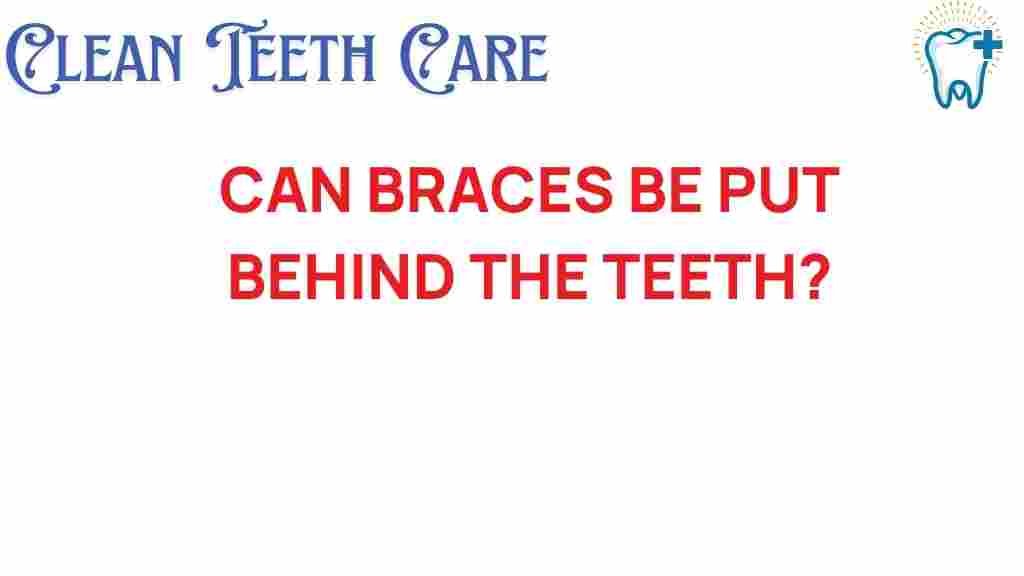Unlocking the Mystery: Can Braces Really Be Hidden Behind Your Teeth?
When it comes to achieving the perfect smile, many people consider orthodontic treatments. Braces have long been the go-to solution for teeth alignment, but traditional metal braces can be unsightly and uncomfortable for some. Enter hidden braces, or lingual braces, which offer a discreet alternative for those looking to straighten their teeth without the visible metal. In this article, we will explore the world of hidden braces, their advantages, and what you can expect from this innovative dental treatment.
Understanding Hidden Braces
Hidden braces are a type of orthodontics that are placed on the back side of the teeth, making them virtually invisible from the front. This option is particularly popular among adults and teens who are self-conscious about wearing traditional braces. Below, we delve into how hidden braces work and their benefits over conventional braces.
How Do Hidden Braces Work?
Hidden braces function similarly to traditional braces but are designed to be less noticeable. Here’s a step-by-step breakdown of how they work:
- Consultation: The first step is to schedule a consultation with an orthodontist who specializes in hidden braces. They will assess your teeth alignment and discuss your goals.
- Customized Treatment Plan: After the initial assessment, a personalized treatment plan is created, often including X-rays and 3D imaging to tailor the braces to your specific dental structure.
- Placement of Lingual Braces: The orthodontist will bond the braces to the back of your teeth. This process typically takes about an hour or two.
- Adjustments: Regular appointments will be necessary to adjust the braces and ensure optimal alignment. This usually occurs every 4-8 weeks.
- Retention Phase: Once your treatment is complete, a retainer may be recommended to maintain your new smile.
Advantages of Hidden Braces
Choosing hidden braces comes with a variety of advantages:
- Discreet Appearance: The primary benefit of hidden braces is their invisible nature. They are ideal for individuals who want to maintain a professional appearance.
- Effective Alignment: Just like traditional braces, hidden braces are highly effective in correcting various teeth alignment issues.
- Comfort: While some initial discomfort is common, many find hidden braces to be more comfortable than traditional options since there is less irritation to the gums.
- Improved Oral Hygiene: Although maintaining oral hygiene is crucial regardless of the type of braces, hidden braces are often easier to clean since they are not as visible as traditional braces.
Common Concerns About Hidden Braces
While hidden braces have many benefits, potential patients often have questions or concerns. Here are some common ones:
- Are hidden braces more expensive? Generally, hidden braces can be more expensive than traditional braces due to the specialized training required by the orthodontist and the custom fabrication of the braces.
- Will I have difficulty speaking? Some patients report slight speech difficulties initially, but most adapt within a few weeks.
- Is there extra maintenance required? While hidden braces don’t require special tools, maintaining good oral hygiene is essential. Regular dental cleanings and proper brushing techniques will help keep your teeth healthy.
Choosing an Orthodontist for Hidden Braces
Not all orthodontists offer hidden braces, so it’s essential to find a qualified provider. Here are some tips for finding the right orthodontist:
- Research Credentials: Look for an orthodontist who has specific experience with hidden or lingual braces.
- Read Reviews: Check online reviews and testimonials from previous patients to gauge their experiences.
- Schedule a Consultation: Meet with the orthodontist to discuss your goals and ensure you feel comfortable with their approach.
Maintaining Hidden Braces
Proper care is vital to ensure the effectiveness of your hidden braces. Here are some maintenance tips:
- Brush Regularly: Brush your teeth after every meal to prevent plaque buildup.
- Use Floss or Interdental Brushes: These tools can help clean areas around the braces that a regular toothbrush might miss.
- Follow Dietary Recommendations: Avoid hard or sticky foods that could damage the braces.
Troubleshooting Common Issues
As with any dental treatment, you may encounter some challenges. Here are troubleshooting tips for common issues:
- Discomfort or Pain: If you experience discomfort, over-the-counter pain relievers can help. If pain persists, contact your orthodontist.
- Loose Brackets: If a bracket becomes loose, avoid attempting to fix it yourself. Schedule an appointment with your orthodontist as soon as possible.
- Difficulty Speaking: If you have difficulty speaking, practice reading aloud or speaking with friends to help your tongue adjust.
Conclusion
Hidden braces, or lingual braces, offer a remarkable solution for those seeking a discreet yet effective way to achieve a smile transformation. With the ability to correct various teeth alignment issues while remaining virtually invisible, hidden braces are an excellent option for adults and teens alike. By understanding the process, benefits, and maintenance involved, you can make an informed decision about pursuing this innovative orthodontic treatment.
For more information on orthodontics and cosmetic dentistry, consider visiting reputable dental organizations or consult with your local orthodontist. Remember, investing in your smile is investing in your confidence and overall well-being!
Ready to unlock your smile potential? Check out our guide on orthodontic treatments to learn more about your options. For more resources, visit The American Association of Orthodontists.
This article is in the category Treatments and created by CleanTeethCare Team
